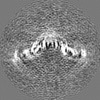+ データを開く
データを開く
- 基本情報
基本情報
| 登録情報 | データベース: EMDB / ID: EMD-20575 | |||||||||
|---|---|---|---|---|---|---|---|---|---|---|
| タイトル | Cryo-EM structure of RET/GFRa1/GDNF extracellular complex | |||||||||
 マップデータ マップデータ | Cryo-EM structure of RET/GFR%u03B11/GDNF extracellular complex. The 3D refinement was applied with C2 symmetry. | |||||||||
 試料 試料 |
| |||||||||
 キーワード キーワード | RET / receptor tyrosine kinase / cryo-EM / SIGNALING PROTEIN | |||||||||
| 機能・相同性 |  機能・相同性情報 機能・相同性情報chemoattractant activity involved in axon guidance / mesenchymal to epithelial transition involved in metanephros morphogenesis / dorsal spinal cord development / positive regulation of mesenchymal to epithelial transition involved in metanephros morphogenesis / ureteric bud formation / positive regulation of ureteric bud formation / regulation of semaphorin-plexin signaling pathway / postganglionic parasympathetic fiber development / glial cell-derived neurotrophic factor receptor activity / glial cell-derived neurotrophic factor receptor binding ...chemoattractant activity involved in axon guidance / mesenchymal to epithelial transition involved in metanephros morphogenesis / dorsal spinal cord development / positive regulation of mesenchymal to epithelial transition involved in metanephros morphogenesis / ureteric bud formation / positive regulation of ureteric bud formation / regulation of semaphorin-plexin signaling pathway / postganglionic parasympathetic fiber development / glial cell-derived neurotrophic factor receptor activity / glial cell-derived neurotrophic factor receptor binding / postsynaptic membrane organization / Peyer's patch morphogenesis / GDF15-GFRAL signaling pathway / positive regulation of metanephric glomerulus development / embryonic epithelial tube formation / ureter maturation / glial cell-derived neurotrophic factor receptor signaling pathway / lymphocyte migration into lymphoid organs / posterior midgut development / regulation of morphogenesis of a branching structure / neurotrophin receptor activity / regulation of dopamine uptake involved in synaptic transmission / Formation of the ureteric bud / membrane protein proteolysis / Formation of the nephric duct / peristalsis / enteric nervous system development / neuron cell-cell adhesion / positive regulation of dopamine secretion / sympathetic nervous system development / positive regulation of branching involved in ureteric bud morphogenesis / organ induction / peripheral nervous system development / plasma membrane protein complex / commissural neuron axon guidance / metanephros development / NCAM1 interactions / neuron maturation / regulation of stem cell differentiation / positive regulation of extrinsic apoptotic signaling pathway in absence of ligand / mRNA stabilization / positive regulation of cell adhesion mediated by integrin / neural crest cell migration / extrinsic component of membrane / ureteric bud development / regulation of axonogenesis / branching involved in ureteric bud morphogenesis / response to pain / homophilic cell-cell adhesion / RET signaling / positive regulation of cell size / embryonic organ development / negative regulation of extrinsic apoptotic signaling pathway in absence of ligand / regulation of cell adhesion / cellular response to retinoic acid / NPAS4 regulates expression of target genes / multivesicular body / transmembrane receptor protein tyrosine kinase activity / axon guidance / cell surface receptor protein tyrosine kinase signaling pathway / adult locomotory behavior / positive regulation of cell differentiation / growth factor activity / kidney development / positive regulation of neuron projection development / receptor protein-tyrosine kinase / receptor tyrosine kinase binding / male gonad development / integrin binding / neuron projection development / cell migration / nervous system development / MAPK cascade / signaling receptor activity / regulation of gene expression / RAF/MAP kinase cascade / protein tyrosine kinase activity / negative regulation of neuron apoptotic process / cell surface receptor signaling pathway / positive regulation of phosphatidylinositol 3-kinase/protein kinase B signal transduction / receptor complex / positive regulation of MAPK cascade / endosome membrane / positive regulation of cell migration / signaling receptor binding / axon / external side of plasma membrane / neuronal cell body / positive regulation of cell population proliferation / calcium ion binding / positive regulation of gene expression / negative regulation of apoptotic process / positive regulation of DNA-templated transcription / Golgi apparatus / signal transduction / protein homodimerization activity / positive regulation of transcription by RNA polymerase II / extracellular space / extracellular exosome / extracellular region 類似検索 - 分子機能 | |||||||||
| 生物種 |  Homo sapiens (ヒト) Homo sapiens (ヒト) | |||||||||
| 手法 | 単粒子再構成法 / クライオ電子顕微鏡法 / 解像度: 4.4 Å | |||||||||
 データ登録者 データ登録者 | Li J / Shang GJ | |||||||||
 引用 引用 |  ジャーナル: Elife / 年: 2019 ジャーナル: Elife / 年: 2019タイトル: Cryo-EM analyses reveal the common mechanism and diversification in the activation of RET by different ligands. 著者: Jie Li / Guijun Shang / Yu-Ju Chen / Chad A Brautigam / Jen Liou / Xuewu Zhang / Xiao-Chen Bai /  要旨: RET is a receptor tyrosine kinase (RTK) that plays essential roles in development and has been implicated in several human diseases. Different from most of RTKs, RET requires not only its cognate ...RET is a receptor tyrosine kinase (RTK) that plays essential roles in development and has been implicated in several human diseases. Different from most of RTKs, RET requires not only its cognate ligands but also co-receptors for activation, the mechanisms of which remain unclear due to lack of high-resolution structures of the ligand/co-receptor/receptor complexes. Here, we report cryo-EM structures of the extracellular region ternary complexes of GDF15/GFRAL/RET, GDNF/GFRα1/RET, NRTN/GFRα2/RET and ARTN/GFRα3/RET. These structures reveal that all the four ligand/co-receptor pairs, while using different atomic interactions, induce a specific dimerization mode of RET that is poised to bring the two kinase domains into close proximity for cross-phosphorylation. The NRTN/GFRα2/RET dimeric complex further pack into a tetrameric assembly, which is shown by our cell-based assays to regulate the endocytosis of RET. Our analyses therefore reveal both the common mechanism and diversification in the activation of RET by different ligands. | |||||||||
| 履歴 |
|
- 構造の表示
構造の表示
| ムービー |
 ムービービューア ムービービューア |
|---|---|
| 構造ビューア | EMマップ:  SurfView SurfView Molmil Molmil Jmol/JSmol Jmol/JSmol |
| 添付画像 |
- ダウンロードとリンク
ダウンロードとリンク
-EMDBアーカイブ
| マップデータ |  emd_20575.map.gz emd_20575.map.gz | 38.1 MB |  EMDBマップデータ形式 EMDBマップデータ形式 | |
|---|---|---|---|---|
| ヘッダ (付随情報) |  emd-20575-v30.xml emd-20575-v30.xml emd-20575.xml emd-20575.xml | 15.1 KB 15.1 KB | 表示 表示 |  EMDBヘッダ EMDBヘッダ |
| 画像 |  emd_20575.png emd_20575.png | 319.2 KB | ||
| Filedesc metadata |  emd-20575.cif.gz emd-20575.cif.gz | 6.2 KB | ||
| アーカイブディレクトリ |  http://ftp.pdbj.org/pub/emdb/structures/EMD-20575 http://ftp.pdbj.org/pub/emdb/structures/EMD-20575 ftp://ftp.pdbj.org/pub/emdb/structures/EMD-20575 ftp://ftp.pdbj.org/pub/emdb/structures/EMD-20575 | HTTPS FTP |
-検証レポート
| 文書・要旨 |  emd_20575_validation.pdf.gz emd_20575_validation.pdf.gz | 579.3 KB | 表示 |  EMDB検証レポート EMDB検証レポート |
|---|---|---|---|---|
| 文書・詳細版 |  emd_20575_full_validation.pdf.gz emd_20575_full_validation.pdf.gz | 578.8 KB | 表示 | |
| XML形式データ |  emd_20575_validation.xml.gz emd_20575_validation.xml.gz | 5.7 KB | 表示 | |
| CIF形式データ |  emd_20575_validation.cif.gz emd_20575_validation.cif.gz | 6.6 KB | 表示 | |
| アーカイブディレクトリ |  https://ftp.pdbj.org/pub/emdb/validation_reports/EMD-20575 https://ftp.pdbj.org/pub/emdb/validation_reports/EMD-20575 ftp://ftp.pdbj.org/pub/emdb/validation_reports/EMD-20575 ftp://ftp.pdbj.org/pub/emdb/validation_reports/EMD-20575 | HTTPS FTP |
-関連構造データ
- リンク
リンク
| EMDBのページ |  EMDB (EBI/PDBe) / EMDB (EBI/PDBe) /  EMDataResource EMDataResource |
|---|---|
| 「今月の分子」の関連する項目 |
- マップ
マップ
| ファイル |  ダウンロード / ファイル: emd_20575.map.gz / 形式: CCP4 / 大きさ: 40.6 MB / タイプ: IMAGE STORED AS FLOATING POINT NUMBER (4 BYTES) ダウンロード / ファイル: emd_20575.map.gz / 形式: CCP4 / 大きさ: 40.6 MB / タイプ: IMAGE STORED AS FLOATING POINT NUMBER (4 BYTES) | ||||||||||||||||||||||||||||||||||||||||||||||||||||||||||||||||||||
|---|---|---|---|---|---|---|---|---|---|---|---|---|---|---|---|---|---|---|---|---|---|---|---|---|---|---|---|---|---|---|---|---|---|---|---|---|---|---|---|---|---|---|---|---|---|---|---|---|---|---|---|---|---|---|---|---|---|---|---|---|---|---|---|---|---|---|---|---|---|
| 注釈 | Cryo-EM structure of RET/GFR%u03B11/GDNF extracellular complex. The 3D refinement was applied with C2 symmetry. | ||||||||||||||||||||||||||||||||||||||||||||||||||||||||||||||||||||
| 投影像・断面図 | 画像のコントロール
画像は Spider により作成 | ||||||||||||||||||||||||||||||||||||||||||||||||||||||||||||||||||||
| ボクセルのサイズ | X=Y=Z: 1.07 Å | ||||||||||||||||||||||||||||||||||||||||||||||||||||||||||||||||||||
| 密度 |
| ||||||||||||||||||||||||||||||||||||||||||||||||||||||||||||||||||||
| 対称性 | 空間群: 1 | ||||||||||||||||||||||||||||||||||||||||||||||||||||||||||||||||||||
| 詳細 | EMDB XML:
CCP4マップ ヘッダ情報:
| ||||||||||||||||||||||||||||||||||||||||||||||||||||||||||||||||||||
-添付データ
- 試料の構成要素
試料の構成要素
-全体 : RET, GFRAL and GDF15 extracellular complex
| 全体 | 名称: RET, GFRAL and GDF15 extracellular complex |
|---|---|
| 要素 |
|
-超分子 #1: RET, GFRAL and GDF15 extracellular complex
| 超分子 | 名称: RET, GFRAL and GDF15 extracellular complex / タイプ: complex / ID: 1 / 親要素: 0 / 含まれる分子: #1-#3 |
|---|---|
| 由来(天然) | 生物種:  Homo sapiens (ヒト) Homo sapiens (ヒト) |
| 分子量 | 理論値: 200 kDa/nm |
-分子 #1: Glial cell line-derived neurotrophic factor
| 分子 | 名称: Glial cell line-derived neurotrophic factor / タイプ: protein_or_peptide / ID: 1 / コピー数: 2 / 光学異性体: LEVO |
|---|---|
| 由来(天然) | 生物種:  Homo sapiens (ヒト) Homo sapiens (ヒト) |
| 分子量 | 理論値: 15.096242 KDa |
| 組換発現 | 生物種:  |
| 配列 | 文字列: SPDKQMAVLP RRERNRQAAA ANPENSRGKG RRGQRGKNRG CVLTAIHLNV TDLGLGYETK EELIFRYCSG SCDAAETTYD KILKNLSRN RRLVSDKVGQ ACCRPIAFDD DLSFLDDNLV YHILRKHSAK RCGCI UniProtKB: Glial cell line-derived neurotrophic factor |
-分子 #2: GDNF family receptor alpha-1
| 分子 | 名称: GDNF family receptor alpha-1 / タイプ: protein_or_peptide / ID: 2 / コピー数: 2 / 光学異性体: LEVO |
|---|---|
| 由来(天然) | 生物種:  Homo sapiens (ヒト) Homo sapiens (ヒト) |
| 分子量 | 理論値: 46.358551 KDa |
| 組換発現 | 生物種:  Homo sapiens (ヒト) Homo sapiens (ヒト) |
| 配列 | 文字列: DRLDCVKASD QCLKEQSCST KYRTLRQCVA GKETNFSLAS GLEAKDECRS AMEALKQKSL YNCRCKRGMK KEKNCLRIYW SMYQSLQGN DLLEDSPYEP VNSRLSDIFR VVPFISDVFQ QVEHIPKGNN CLDAAKACNL DDICKKYRSA YITPCTTSVS N DVCNRRKC ...文字列: DRLDCVKASD QCLKEQSCST KYRTLRQCVA GKETNFSLAS GLEAKDECRS AMEALKQKSL YNCRCKRGMK KEKNCLRIYW SMYQSLQGN DLLEDSPYEP VNSRLSDIFR VVPFISDVFQ QVEHIPKGNN CLDAAKACNL DDICKKYRSA YITPCTTSVS N DVCNRRKC HKALRQFFDK VPAKHSYGML FCSCRDIACT ERRRQTIVPV CSYEEREKPN CLNLQDSCKT NYICRSRLAD FF TNCQPES RSVSSCLKEN YADCLLAYSG LIGTVMTPNY IDSSSLSVAP WCDCSNSGND LEECLKFLNF FKDNTCLKNA IQA FGNGSD VTVWQPAFPV QTTTATTTTA LRVKNKPLGP AGSENEIPTH VLPPCANLQA QKLKSNVSGN THLCISNGNY EKEG LGGTH HHHHHHH UniProtKB: GDNF family receptor alpha-1 |
-分子 #3: Proto-oncogene tyrosine-protein kinase receptor Ret
| 分子 | 名称: Proto-oncogene tyrosine-protein kinase receptor Ret / タイプ: protein_or_peptide / ID: 3 / コピー数: 2 / 光学異性体: LEVO / EC番号: receptor protein-tyrosine kinase |
|---|---|
| 由来(天然) | 生物種:  Homo sapiens (ヒト) Homo sapiens (ヒト) |
| 分子量 | 理論値: 69.100812 KDa |
| 組換発現 | 生物種:  Homo sapiens (ヒト) Homo sapiens (ヒト) |
| 配列 | 文字列: LYFSRDAYWE KLYVDQAAGT PLLYVHALRD APEEVPSFRL GQHLYGTYRT RLHENNWICI QEDTGLLYLN RSLDHSSWEK LSVRNHGFP LLTVYLKVFL SPTSLREGEC QWPGCARVYF SFFNTSFPAC SSLKPRELCF PETRPSFRIR ENRPPGTFHQ F RLLPVQFL ...文字列: LYFSRDAYWE KLYVDQAAGT PLLYVHALRD APEEVPSFRL GQHLYGTYRT RLHENNWICI QEDTGLLYLN RSLDHSSWEK LSVRNHGFP LLTVYLKVFL SPTSLREGEC QWPGCARVYF SFFNTSFPAC SSLKPRELCF PETRPSFRIR ENRPPGTFHQ F RLLPVQFL CPNISVAYRL LEGEGLPFRC APDSLEVSTR WALDREQREK YELVAVCTVH AGAREEVVMV PFPVTVYDED DS APTFPAG VDTASAVVEF KRKEDTVVAT LRVFDADVVP ASGELVRRYT STLLPGDTWA QQTFRVEHWP NETSVQANGS FVR ATVHDY RLVLNRNLSI SENRTMQLAV LVNDSDFQGP GAGVLLLHFN VSVLPVSLHL PSTYSLSVSR RARRFAQIGK VCVE NCQAF SGINVQYKLH SSGANCSTLG VVTSAEDTSG ILFVNDTKAL RRPKCAELHY MVVATDQQTS RQAQAQLLVT VEGSY VAEE AGCPLSCAVS KRRLECEECG GLGSPTGRCE WRQGDGKGIT RNFSTCSPST KTCPDGHCDV VETQDINICP QDCLRG SIV GGHEPGEPRG IKAGYGTCNC FPEEEKCFCE PEDIQDPLCD ELCRGTHHHH HHHH UniProtKB: Proto-oncogene tyrosine-protein kinase receptor Ret |
-分子 #4: CALCIUM ION
| 分子 | 名称: CALCIUM ION / タイプ: ligand / ID: 4 / コピー数: 8 / 式: CA |
|---|---|
| 分子量 | 理論値: 40.078 Da |
-実験情報
-構造解析
| 手法 | クライオ電子顕微鏡法 |
|---|---|
 解析 解析 | 単粒子再構成法 |
| 試料の集合状態 | particle |
- 試料調製
試料調製
| 濃度 | 1 mg/mL |
|---|---|
| 緩衝液 | pH: 7.4 |
| 凍結 | 凍結剤: ETHANE / チャンバー内湿度: 100 % / チャンバー内温度: 277 K / 装置: FEI VITROBOT MARK IV |
- 電子顕微鏡法
電子顕微鏡法
| 顕微鏡 | FEI TITAN KRIOS |
|---|---|
| 特殊光学系 | エネルギーフィルター - 名称: GIF Quantum LS / エネルギーフィルター - スリット幅: 20 eV |
| 撮影 | フィルム・検出器のモデル: GATAN K2 QUANTUM (4k x 4k) 検出モード: SUPER-RESOLUTION / デジタル化 - 画像ごとのフレーム数: 1-30 / 撮影したグリッド数: 1 / 平均露光時間: 15.0 sec. / 平均電子線量: 50.0 e/Å2 |
| 電子線 | 加速電圧: 300 kV / 電子線源:  FIELD EMISSION GUN FIELD EMISSION GUN |
| 電子光学系 | C2レンズ絞り径: 70.0 µm / 倍率(補正後): 46729 / 照射モード: FLOOD BEAM / 撮影モード: BRIGHT FIELD / Cs: 2.7 mm |
| 試料ステージ | 試料ホルダーモデル: FEI TITAN KRIOS AUTOGRID HOLDER ホルダー冷却材: NITROGEN |
| 実験機器 |  モデル: Titan Krios / 画像提供: FEI Company |
+ 画像解析
画像解析
-原子モデル構築 1
| 精密化 | 空間: REAL / プロトコル: FLEXIBLE FIT / 温度因子: 190 |
|---|---|
| 得られたモデル |  PDB-6q2n: |
 ムービー
ムービー コントローラー
コントローラー



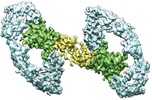




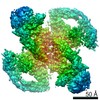








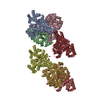
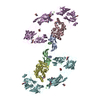
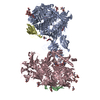
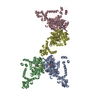

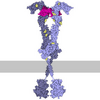






 Z (Sec.)
Z (Sec.) Y (Row.)
Y (Row.) X (Col.)
X (Col.)














